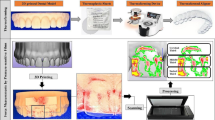Summary
Overdenture as a treatment modality for both partially and fully edentulous patients is costeffective and less expensive. The purpose of the present study was to examine the newly fabricated attachments by comparing them with conventional O-ring attachment in vitro in terms of retention force and cyclic aging resistance. A total of 150 samples were prepared and divided into five groups according to the materials used (O-ring attachment, Deflex M10 XR, Deflex Classic SR, Deflex Acrilato FD, and flexible acrylic resin). The retention force of different attachments was measured by a mini dental implant after three subsequent aging (0, 63, and 126) cycles in the circumstances similar to the oral environment. The gap space between the head of the implant and the inner surface of the attachments was detected. Two-way analysis of variance (ANOVA) analysis with multiple comparisons test was applied for statistical analysis. The results showed that Deflex M10 XR had the highest retention force and the lowest gap space after cyclic aging; in addition, by comparing the relative force reduction, the lowest values were obtained in the O-ring attachment and the highest values in the flexible acrylic resin attachment. The retention force measured after cyclic aging for the Deflex M10 XR attachment was greatly improved when compared with the O-ring attachment and other types of attachment materials; in addition, the Deflex M10 XR attachment exhibited the minimum gap space between the inner surface and the mini dental implant head. In conclusion, Deflex M10 XR has the ability to withstand weathering conditions and retains its durable and retentive properties after aging when compared with other attachments.
Similar content being viewed by others
References
Mijiritsky E, Ormianer Z, Klinger A, et al. Use of dental implants to improve unfavorable removable partial denture design. Compend Contin Educ Dent, 2005,26(10):744–746
Fatalla AA, Song K, Du T, et al. An in vitro investigation into retention strength and fatigue resistance of various designs of tooth/implant supported overdentures. J Huazhong Univ Sci Technolog Med Sci, 2012,32(1):124–129
Doukas D, Michelinakis G, Smith PW, et al. The influence of interimplant distance and attachment type on the retention characteristics of mandibular overdentures on 2 implants: 6-month fatigue retention values. Int J Prosthodont, 2008,21(2):152–154
Setz I, Lee S, Engel E. Retention of prefabricated attachments for implant stabilized overdentures in the edentulous mandible: an in vitro study. J Prosthet Dent, 1998,80(3):323–329
Petropoulos V, Smith W. Maximum dislodging forces of implant overdenture stud attachments. Int J Oral Maxillofac Implants, 2002,17(4):526–535
van Kampen F, Cune M, Van der Bilt A, et al. Retention and postinsertion maintenanace of bar-clip, ball and magnet attachments in mandibular implant overdenture treatment: an in vivo comparison after 3 months of function. Clin Oral Implants Res, 2003,14(6):720–726
Visser A, Meijer H, Raghoebar GM, et al. Implant-retained mandibular overdentures versus conventional dentures: 10 years of care and aftercare. Int J Prosthodont, 2006,19(3):271–278
Liddelow GJ, Henry PJ. A prospective study of immediately loaded single implant-retained mandibular overdentures: Preliminary one-year results. J Prosthet Dent, 2007, 97(Suppl 6):S126–137
Marzola R, Scotti R, Fazi G, et al. Immediate loading of two implants supporting a ball attachment-retained mandibular overdenture: A prospective clinical study. Clin Implant Dent Relat Res, 2007,9(3):136–143
Chung K, Chung C, Cagna D, et al. Retention characteristics of attachment systems for implant overdentures. J Prosthodont, 2004,13(4):221–226
Williams B, Ochiai K, Hojo S, et al. Retention of maxillary implant overdenture bars of different designs. J Prosthet Dent, 2001,86(6):603–607
Botega D, Mesquita M, Henriques G, et al. Retention force and fatigue strength of overdenture attachment systems. J Oral Rehabil, 2004,31(9):884–889
Mericske-Stern RD, Taylor TD, Belser U. Management of the edentulous patient. Clin Oral Implants Res, 2000,11 (Suppl 1):108–125
Porter J, Petropoulos V, Brunski J. Comparison of load distribution for implant overdenture attachments. Int J Oral Maxillofac Implants, 2002,17(5):651–662
Krennmair G, Ulm C. The symphyseal single-tooth implant for anchorage of a mandibular complete denture in geriatric patients: a clinical report. Int J Oral Maxillofac Implants, 2001,16(1):98–104
Tanino F, Hayakawa I, Hirano S, et al. Finite element analysis of stress-breaking attachments on maxillary implant-retained overdentures. Int J Prosthodont, 2007,20(2):193–198
Kanazawa M, Minakuchi S, Hayakawa I, et al. in vitro study of reduction of stress transferred onto tissues around implants using a resilient material in maxillary implant overdentures. J Med Dent Sci, 2007,54(1):17–23
Prasad DK, Prasad DA, Buch M. Selection of attachment systems in fabricating an implant supported overdenture. J dent imp, 2014,4(2):176–181
Alsabeeha NH, Payne AG, Swain MV. Attachment systems for mandibular two-implant overdentures: A review of in vitro investigations on retention and wear features. Int J Prosthodont, 2009,22:429–440
Trakas T, Michalakis K, Kang K, et al. Attachment systems for implant retained overdentures: A literature review. Implant Dent, 2006,15:24–34
http://deflex.com.ar/en/materiales/. [Online] 2015.
John J, Rangarajan V, Savadi RC, et al. A finite element analysis of stress distribution in the bone, around the implant supporting a mandibular overdenture with ball/O ring and magnetic attachment. J Indian Prosthodont Soc, 2012, 12(1):37–44
Walton J, Ruse N. in vitro changes in clips and bars used to retain implant overdentures. J Prosthet Dent, 1995,74(5):482–486
Author information
Authors and Affiliations
Corresponding author
Rights and permissions
About this article
Cite this article
Fatalla, A.A., Song, K. & Cao, Yg. New mini dental implant attachments versus O-ring attachment after cyclic aging: Analysis of retention strength and gap space. J. Huazhong Univ. Sci. Technol. [Med. Sci.] 37, 419–424 (2017). https://doi.org/10.1007/s11596-017-1750-8
Received:
Revised:
Published:
Issue Date:
DOI: https://doi.org/10.1007/s11596-017-1750-8




